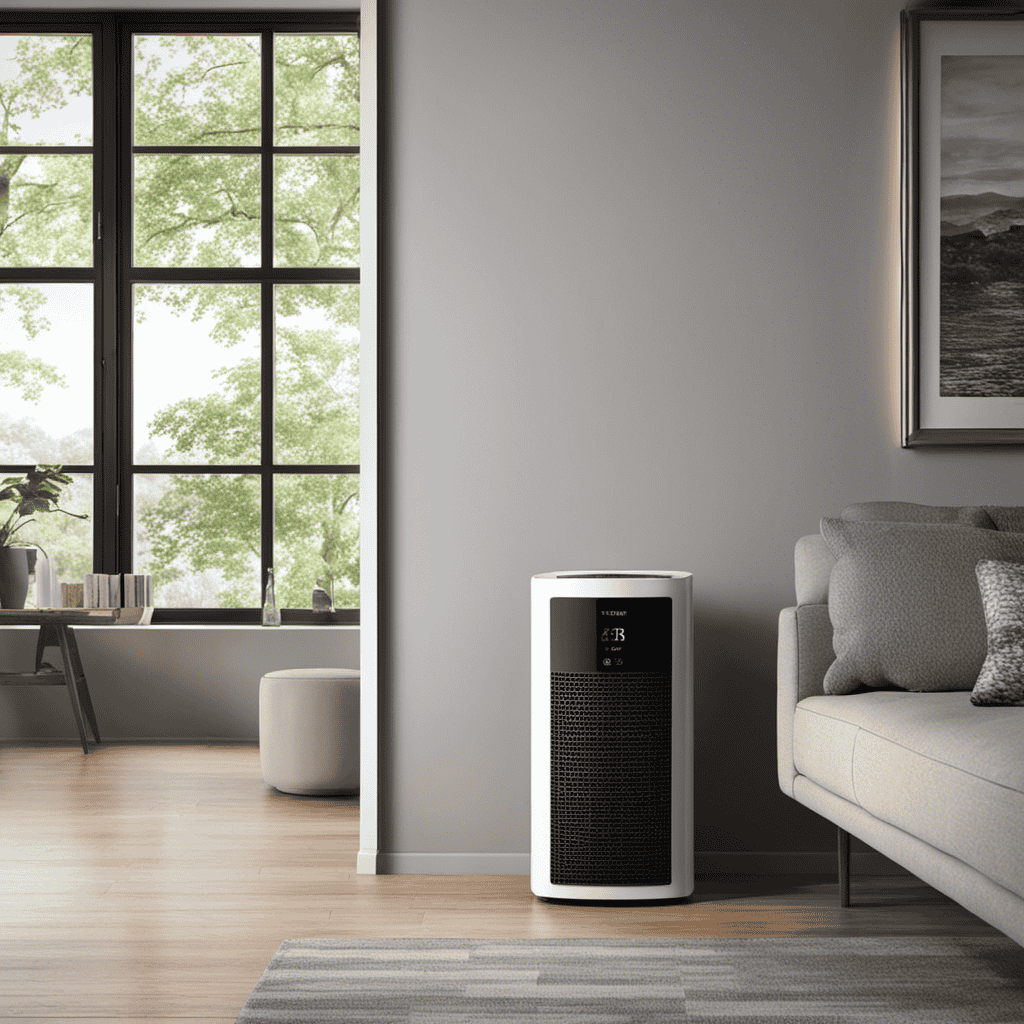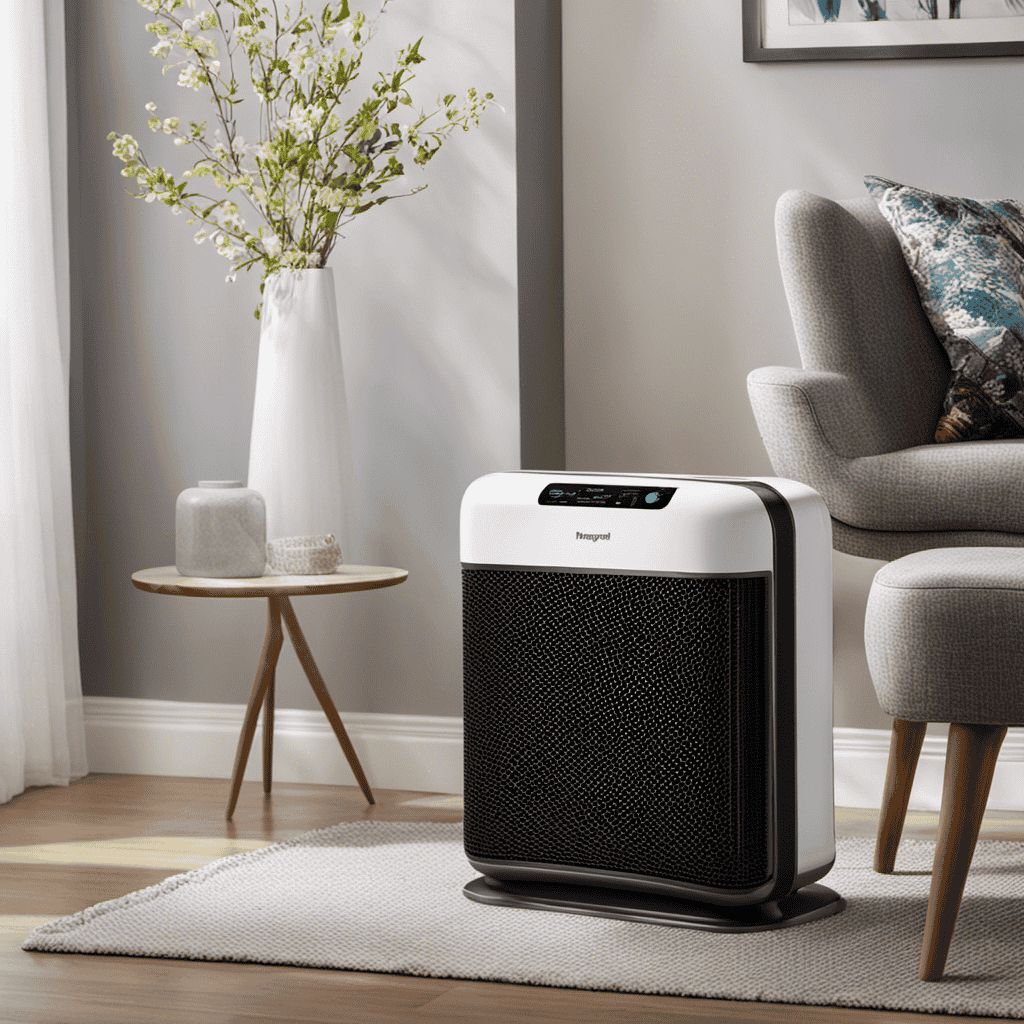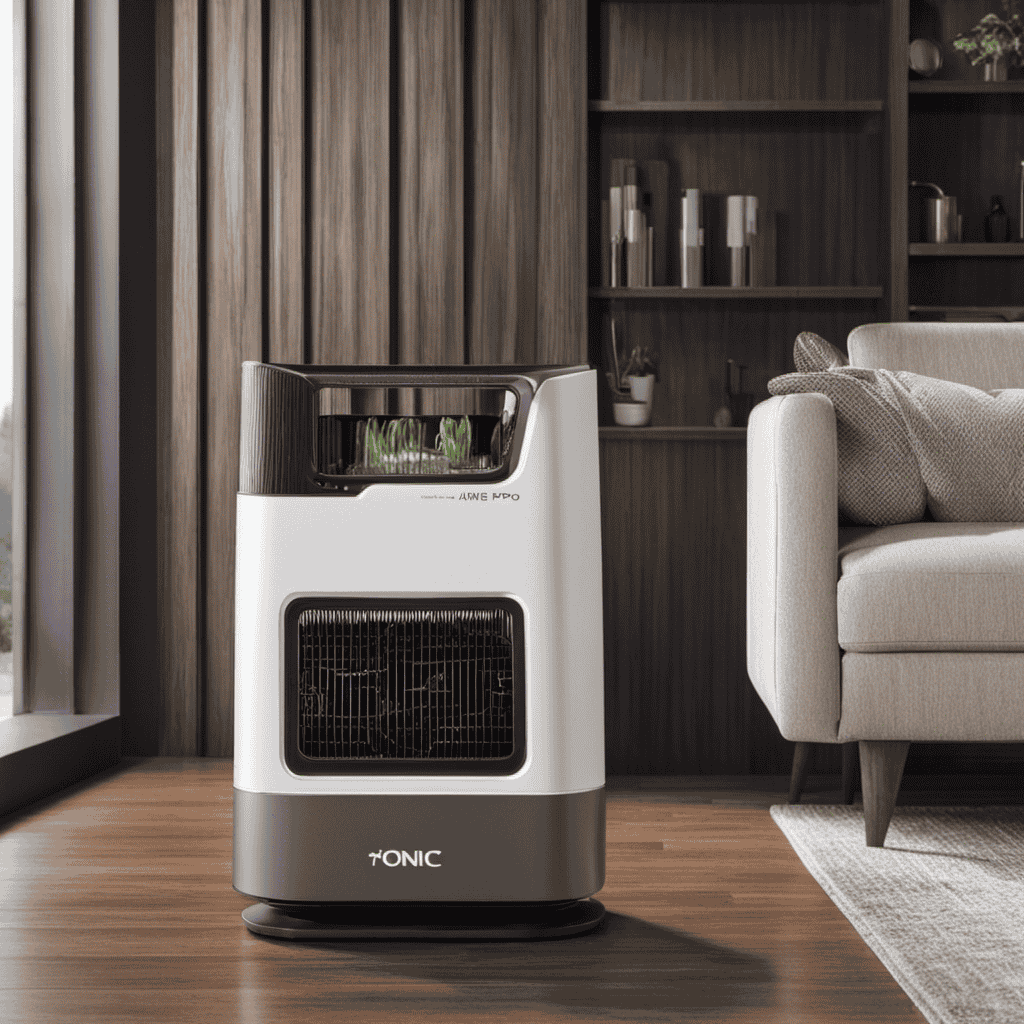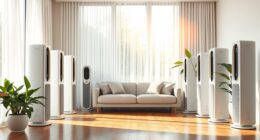As someone passionate about air purifiers, the CADR rating has always captured my curiosity. What does it signify, and why does it hold such significance?
In this article, we’ll delve into the world of CADR ratings and explore their impact on air purification efficiency. From the factors that influence CADR rating to tips on improving it, we’ll leave no stone unturned.
So, if you’re curious about how CADR rating can make a difference in your air purifier’s performance, keep reading!
Key Takeaways
- CADR rating determines the effectiveness of an air purifier in removing pollutants from the air.
- Higher CADR rating indicates a more efficient air purifier.
- Investing in an air purifier with a high CADR rating brings benefits like improved respiratory health and reduced allergy symptoms.
- CADR rating helps in comparing different air purifiers.
Understanding CADR Rating
The CADR rating determines how effective an air purifier is at removing pollutants from the air. Understanding the CADR calculation is essential in choosing the right air purifier for your needs.
CADR stands for Clean Air Delivery Rate, and it measures the volume of clean air that an air purifier can provide in a specific period. The CADR rating takes into account three main pollutants: smoke, dust, and pollen. The higher the CADR rating, the more efficient the air purifier is at removing these pollutants.
A high CADR rating means that the air purifier can clean the air faster and more effectively, providing you with cleaner and healthier indoor air. Investing in an air purifier with a high CADR rating brings numerous benefits, including improved respiratory health, reduced allergy symptoms, and a cleaner living environment.
The Importance of CADR Rating for Air Purifiers
Understanding the importance of CADR ratings helps you choose the most effective air purifier for your needs. CADR, or Clean Air Delivery Rate, measures the efficiency of an air purifier in removing pollutants such as dust, pollen, and smoke from the air. By considering the CADR rating, you can ensure that you are investing in a high-performing air purifier that will effectively improve the air quality in your home or office.
CADR ratings are determined by independent testing organizations such as the Association of Home Appliance Manufacturers (AHAM). They follow strict standards to ensure accuracy and consistency across different brands and models. These standards consider the volume of air processed by the purifier, as well as the percentage of pollutants removed.
By referring to the CADR rating, you can compare different air purifiers and choose the one that best suits your needs. The higher the CADR rating, the more efficient the air purifier is at removing pollutants from the air. This means that you can enjoy cleaner and healthier air in your living or working space.
| Pollutant | CADR Rating | Recommended Room Size |
|---|---|---|
| Dust | 200 | 300 sq. ft. |
| Pollen | 180 | 270 sq. ft. |
| Smoke | 220 | 330 sq. ft. |
How CADR Rating Affects Air Purification Efficiency
When it comes to the effectiveness of air purifiers, two key factors to consider are CADR rating and filtration effectiveness.
CADR, or Clean Air Delivery Rate, measures how quickly an air purifier can remove common pollutants from the air. A higher CADR rating indicates a faster and more efficient purification process.
Understanding the impact of CADR on air quality is essential for choosing the right air purifier to ensure a healthier and cleaner indoor environment.
CADR and Filtration Effectiveness
CADR measures the effectiveness of an air purifier in filtering pollutants. It is an important factor to consider when choosing an air purifier as it indicates how quickly and efficiently the purifier can clean the air in a given space. The CADR rating is determined through standardized testing, which measures the filtration efficiency of the purifier. However, it is important to note that the accuracy of CADR ratings can vary depending on the testing conditions and methodologies used by different manufacturers. To help you understand the significance of CADR ratings, here is a table that compares the CADR ratings of three popular air purifiers:
| Air Purifier Model | CADR Rating for Smoke | CADR Rating for Dust | CADR Rating for Pollen |
|---|---|---|---|
| Model A | 300 | 250 | 200 |
| Model B | 250 | 200 | 150 |
| Model C | 200 | 150 | 100 |
As you can see from the table, higher CADR ratings indicate better filtration efficiency for different types of pollutants. Therefore, when choosing an air purifier, it is essential to consider the CADR rating accuracy and select a model that suits your specific needs.
Impact of CADR on Air Quality
To improve the air quality in your home, consider the impact of a higher CADR rating on the effectiveness of the air purifier. A higher CADR rating means that the air purifier can remove more pollutants from the air in a shorter amount of time. This is crucial for maintaining good indoor air quality, as pollutants like dust, pollen, and pet dander can cause allergies and respiratory problems.
Additionally, a higher CADR rating ensures that the air purifier is more energy efficient, saving you money on electricity bills. Investing in an air purifier with a higher CADR rating not only benefits your health but also contributes to a cleaner and more comfortable living environment.
- Breathe easier and reduce allergy symptoms
- Create a healthier living space for you and your family
- Eliminate odors and improve the overall freshness of your home
- Enhance your well-being and promote a better quality of life
Factors That Influence CADR Rating
You should consider factors such as room size and air flow when determining the CADR rating for an air purifier.
The CADR rating, or Clean Air Delivery Rate, measures how efficiently an air purifier can remove pollutants from the air. Several factors can affect the CADR rating of an air purifier.
One important factor is the size of the room in which the purifier will be used. A larger room will require a higher CADR rating to effectively clean the air.
Another factor is the level of air pollution in the room. If the pollution levels are high, a higher CADR rating will be needed to combat the pollutants effectively.
Finally, the airflow in the room also plays a role in determining the CADR rating. Proper airflow ensures that the purifier can circulate and filter the air efficiently, resulting in a higher CADR rating.
Therefore, when choosing an air purifier, it is crucial to consider these factors to ensure that the selected purifier has an appropriate CADR rating for your specific needs.
How to Interpret CADR Rating for Air Purifiers
When it comes to air purifiers, understanding the significance of the CADR (Clean Air Delivery Rate) rating is crucial.
The CADR rating measures the effectiveness of an air purifier in removing specific pollutants from the air, such as smoke, dust, and pollen.
This rating is an important factor to consider when choosing the right purifier for your needs, as it indicates how well the device can clean the air in a given space.
CADR Rating Significance
The CADR rating is important because it measures the air purifier’s effectiveness in removing pollutants from the air. It is a crucial factor to consider when choosing an air purifier.
Here are some reasons why the CADR rating is significant:
-
Health Benefits: A higher CADR rating means that the air purifier can remove more pollutants, such as dust, pollen, and smoke, from the air. This leads to improved indoor air quality and can help reduce allergies and respiratory issues.
-
Efficiency: An air purifier with a high CADR rating can clean the air faster and more efficiently, providing you with cleaner and fresher air in a shorter amount of time.
-
Peace of Mind: Knowing that your air purifier has a high CADR rating gives you peace of mind, knowing that it is effectively removing pollutants from the air and creating a healthier living environment.
-
Cost-Effectiveness: Investing in an air purifier with a high CADR rating ensures that you are getting a product that is efficient and effective, saving you money in the long run by reducing the need for frequent filter replacements or maintenance.
Choosing the Right Purifier
Choosing the right purifier is essential for improving indoor air quality and reducing respiratory issues. When considering air purifiers, there are several features to look for.
First, consider the type of filtration system it uses. HEPA filters are highly effective in removing airborne particles, while activated carbon filters are great for eliminating odors and chemicals.
Look for purifiers with multiple fan speeds to customize the airflow according to your needs. Additionally, features like a timer and sleep mode can enhance convenience and energy efficiency.
Maintenance is also crucial for optimal performance. Regularly clean or replace filters as recommended by the manufacturer to ensure the purifier is working at its best. It’s also important to clean the purifier’s exterior and keep it free from dust and debris.
Choosing the Right CADR Rating for Your Needs
To find the right CADR rating for your needs, you should consider the size of your room and how often you use the air purifier. The CADR, or Clean Air Delivery Rate, is a measure of how effectively an air purifier can remove common airborne pollutants from a room.
Here are four important factors to consider when understanding CADR ratings:
-
Room Size: A larger room will require a higher CADR rating to effectively clean the air.
-
Pollutant Type: Different pollutants require different CADR ratings. Consider the specific contaminants you want to remove, such as pollen, dust, or smoke.
-
Usage Frequency: If you plan to run the air purifier continuously, you may need a higher CADR rating compared to occasional use.
-
Allergies or Sensitivities: If you or someone in your household has allergies or respiratory issues, it’s important to choose an air purifier with a higher CADR rating to ensure cleaner air.
Tips for Improving CADR Rating of Air Purifiers
If you want to improve the CADR rating of your air purifier, consider cleaning or replacing the filters regularly. This is an important step in improving airflow and optimizing filtration.
Filters play a crucial role in removing airborne particles, such as dust, pollen, and pet dander, from the air. Over time, these particles can clog the filters, reducing their effectiveness and limiting the airflow.
By cleaning or replacing the filters, you can ensure that your air purifier is operating at its best and maximizing its CADR rating.
Additionally, consider placing your air purifier in a strategic location to further improve airflow. Placing it near a wall or away from furniture can help prevent obstructions and allow for better circulation.
Taking these steps will not only improve the CADR rating of your air purifier but also ensure cleaner and healthier air in your home.
The Relationship Between CADR Rating and Room Size
When it comes to evaluating the effectiveness of air purifiers, the CADR rating plays a crucial role. The CADR rating, or Clean Air Delivery Rate, indicates how efficiently an air purifier can remove specific types of pollutants from the air.
Understanding the relationship between CADR rating and room size is essential for choosing the right air purifier for your space, as different room sizes require different CADR ratings to effectively clean the air.
CADR Rating and Effectiveness
You can easily assess the effectiveness of an air purifier by looking at its CADR rating. The CADR rating, or Clean Air Delivery Rate, measures how efficiently an air purifier can remove common airborne pollutants from a specific room size.
To calculate the CADR rating, the air purifier is tested in a controlled environment and the amount of clean air it can deliver per minute is measured. The higher the CADR rating, the more effective the air purifier is at removing pollutants. CADR rating standards vary depending on the type of pollutant, such as smoke, dust, or pollen.
When considering an air purifier, keep in mind the following factors:
- High CADR rating: Provides faster and more efficient air cleaning
- Room size: Ensure the CADR rating is suitable for your room size
- Pollutant type: Look for specific CADR ratings for different pollutants
- Maintenance: Regularly clean or replace filters for optimal performance
Room Size Considerations
When considering an air purifier for a room, it is important to take into account the room size and layout. The effectiveness of an air purifier is directly related to its Clean Air Delivery Rate (CADR) rating, which indicates how quickly it can clean the air in a specific room size. A larger room will require a higher CADR rating to effectively purify the air. Additionally, the layout of the room can impact the airflow and distribution of purified air. It is important to place the air purifier in a central location to allow for optimal air circulation. Furthermore, the noise level of an air purifier should also be considered, especially if it will be used in a bedroom or office space where quietness is desired.
To help visualize the room size considerations when choosing an air purifier, refer to the table below:
| Room Size | CADR Rating (Recommended) |
|---|---|
| Small (100 sq. ft. or less) | 60-100 |
| Medium (101-300 sq. ft.) | 120-180 |
| Large (301-500 sq. ft.) | 200-320 |
| Extra Large (501 sq. ft. or more) | 330-450 |
Comparing Air Purifiers Based on CADR Rating
Comparing air purifiers based on their CADR rating can help you determine their effectiveness in improving indoor air quality. The CADR rating stands for Clean Air Delivery Rate and it measures how quickly and efficiently an air purifier can filter and clean the air in a given space.
When choosing an air purifier, it’s important to consider the room size and the air purification efficiency. Here are four key factors to consider:
-
Room size: Different air purifiers are designed to clean different room sizes. It’s important to choose an air purifier that is suitable for the size of the room you want to purify. Using an air purifier that is too small for the room may not effectively clean the air.
-
Air purification efficiency: Look for an air purifier with a high CADR rating. A higher CADR rating indicates that the air purifier can remove more airborne pollutants, such as dust, pollen, and smoke, from the air in a shorter amount of time.
-
Filter type: Consider the type of filter used in the air purifier. High-efficiency particulate air (HEPA) filters are known for their effectiveness in capturing small particles and allergens.
-
Noise level: Pay attention to the noise level of the air purifier. Some models may produce loud noises, which can be disruptive and bothersome, especially if you plan to use the purifier in a bedroom or office.
Common Misconceptions About CADR Rating for Air Purifiers
Don’t be fooled by common misconceptions about the effectiveness of CADR ratings in air purifiers. While some people may believe that CADR ratings are not a reliable indicator of an air purifier’s performance, this is simply not true. CADR, or Clean Air Delivery Rate, is a standardized measurement that provides valuable information about an air purifier’s ability to remove specific pollutants from the air.
One common misconception is that a higher CADR rating automatically means a better air purifier. While a higher CADR rating does indicate a faster and more efficient air cleaning process, it is important to consider the specific needs of your environment. For example, a higher CADR rating in smoke removal may not be as important if you primarily need an air purifier for pollen or dust removal.
To help you better understand the benefits of CADR ratings, here is a table showcasing the typical CADR ratings for different pollutants:
| Pollutant | CADR Rating Range |
|---|---|
| Smoke | 10 – 450 |
| Pollen | 25 – 450 |
| Dust | 10 – 400 |
As you can see, CADR ratings cover a wide range, allowing you to choose an air purifier that is specifically tailored to your needs. So, don’t fall for the misconceptions surrounding CADR ratings – they are an important tool in selecting an effective air purifier for your home or office.
Frequently Asked Questions
Can the CADR Rating Be Used to Determine the Effectiveness of an Air Purifier in Removing Specific Contaminants or Allergens?
Yes, the CADR rating can be used to determine the effectiveness of an air purifier in removing specific contaminants or allergens. It provides a quantitative measure of how quickly the purifier can remove particles of different sizes from the air.
Is the CADR Rating the Only Factor to Consider When Choosing an Air Purifier?
When choosing an air purifier, the CADR rating is important, but not the only factor. Consider other features like filter type, noise level, and maintenance requirements to ensure the best air quality.
Can the CADR Rating of an Air Purifier Change Over Time?
The CADR rating of an air purifier can be influenced by various factors, including the effect of maintenance on the rating and the impact of air quality. It is important to consider these factors when evaluating the performance of an air purifier.
Are There Any Regulations or Standards That Govern the CADR Rating of Air Purifiers?
There are regulations and standards that govern the CADR rating of air purifiers. These guidelines ensure that manufacturers provide accurate and reliable information about a purifier’s ability to remove specific airborne pollutants.
How Does the CADR Rating of an Air Purifier Relate to Its Energy Consumption?
The relationship between the CADR rating and energy consumption of an air purifier is important to consider. It allows me to assess how efficiently the purifier can clean the air while using minimal energy.
Conclusion
In conclusion, understanding the CADR rating for air purifiers is crucial for ensuring effective air purification. The CADR rating directly affects the efficiency of the air purifier in removing pollutants from the air. Factors such as room size and the type of pollutants present influence the CADR rating.
By comparing air purifiers based on their CADR ratings, consumers can make informed decisions about which one best suits their needs. Don’t let misconceptions cloud your judgment, delve into the details and choose wisely.
Remember, knowledge is power when it comes to clean air.










